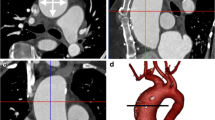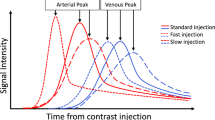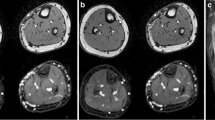Abstract
Magnetic resonance angiography (MRA) in general and MRA of the abdominal vessels in particular have undergone substantial improvements in the past 5 years triggered by the introduction and application of parallel imaging (PI), new sequence techniques such as centric k-space trajectories and undersampling, dedicated contrast agents and clinical high-field scanners. All of these techniques have the potential to improve image quality and resolution or decrease the image acquisition time. However, each of them has its own specific advantages and drawbacks. This review describes the main technical innovations and focuses on the impact these developments may have on abdominal MRA. Special consideration is given to the interaction of these various technical advances. The clinical value of advanced MRA techniques is discussed and illustrated by characteristic cases.














Similar content being viewed by others
References
Vosshenrich R, Fischer U (2002) Contrast-enhanced MR angiography of abdominal vessels: is there still a role for angiography? Eur Radiol 12:218–230
Bongartz GM, Boos M, Winter K et al (1997) Clinical utility of contrast-enhanced MR angiography. Eur Radiol 7[Suppl 5]:178–186
Nael K, Laub G, Finn JP (2005) Three-dimensional contrast-enhanced MR angiography of the thoraco-abdominal vessels. Magn Reson Imaging Clin N Am 13:359–380
Therasse E, Soulez G, Roy P et al (1998) Lower extremity: nonstepping digital angiography with photostimulable imaging plates versus conventional angiography. Radiology 207:695–703
Vasbinder GB, Nelemans PJ, Kessels AG et al (2004) Accuracy of computed tomographic angiography and magnetic resonance angiography for diagnosing renal artery stenosis. Ann Intern Med 141:674–682
Hoogeveen RM, Bakker CJ, Viergever MA (1998) Limits to the accuracy of vessel diameter measurement in MR angiography. J Magn Reson Imaging 8:1228–1235
Westenberg JJ, van der Geest RJ, Wasser MN et al (2000) Vessel diameter measurements in gadolinium contrast-enhanced three-dimensional MRA of peripheral arteries. Magn Reson Imaging 18:13–22
Schoenberg SO, Rieger J, Weber CH et al (2005) High-spatial-resolution MR angiography of renal arteries with integrated parallel acquisitions: comparison with digital subtraction angiography and US. Radiology 235:687–698
Ota H, Takase K, Rikimaru H et al (2005) Quantitative vascular measurements in arterial occlusive disease. Radiographics 25:1141–1158
Vasbinder GBC, Maki JH, Nijenhuis RJ et al (2002) Motion of the distal renal artery during three-dimensional contrast-enhanced breath-hold MRA. J Magn Reson Imaging 16:685–696
Born M, Willinek WA, Gieseke J et al (2005) Sensitivity encoding (SENSE) for contrast-enhanced 3D MR angiography of the abdominal arteries. J Magn Reson Imaging 22:559–565
Michaely HJ, Herrmann KA, Kramer EL et al (2006) High-resolution renal MRA: comparison of image quality and vessel depiction with different parallel imaging acceleration factors. J Magn Reson Imaging (in press)
Schoenberg SO, Bock M, Knopp MV et al (1999) Renal arteries: optimization of three-dimensional gadolinium-enhanced MR angiography with bolus-timing-independent fast multiphase acquisition in a single breath hold. Radiology 211:667–679
Campeau NG, Huston J 3rd, Bernstein MA, Lin C, Gibbs GF (2001) Magnetic resonance angiography at 3.0 Tesla: initial clinical experience. Top Magn Reson Imaging 12:183–204
Lin W, An H, Chen Y et al (2003) Practical consideration for 3T imaging. Magn Reson Imaging Clin N Am 11:615–639, vi
Schmitt F, Grosu D, Mohr C et al (2004) 3 Tesla MRI: successful results with higher field strengths. Radiologe 44:31–47
Rohrer M, Bauer H, Mintorovitch J, Requardt M, Weinmann HJ (2005) Comparison of magnetic properties of MRI contrast media solutions at different magnetic field strengths. Invest Radiol 40:715–724
Kramer H, Schoenberg SO, Nikolaou K et al (2005) Cardiovascular screening with parallel imaging techniques and a whole-body MR imager. Radiology 236:300–310
Hardy CJ, Darrow RD, Saranathan M et al (2004) Large field-of-view real-time MRI with a 32-channel system. Magn Reson Med 52:878–884
Fenchel M, Requardt M, Tomaschko K et al (2005) Whole-body MR angiography using a novel 32-receiving-channel MR system with surface coil technology: first clinical experience. J Magn Reson Imaging 21:596–603
Pruessmann KP, Weiger M, Scheidegger MB, Boesiger P (1999) SENSE: sensitivity encoding for fast MRI. Magn Reson Med 42:952–962
Griswold MA, Jakob PM, Heidemann RM et al (2002) Generalized autocalibrating partially parallel acquisitions (GRAPPA). Magn Reson Med 47:1202–1210
Griswold MA, Kannengiesser S, Heidemann RM, Wang J, Jakob PM (2004) Field-of-view limitations in parallel imaging. Magn Reson Med 52:1118–1126
Goldfarb JW (2004) The SENSE ghost: field-of-view restrictions for SENSE imaging. J Magn Reson Imaging 20:1046–1051
Heidemann RM, Griswold MA, Muller M et al (2004) Feasibilities and limitations of high field parallel MRI. Radiologe 44:49–55
Wu Y, Goodrich KC, Buswell HR, Katzman GL, Parker DL (2004) High-resolution time-resolved contrast-enhanced 3D MRA by combining SENSE with keyhole and SLAM strategies. Magn Reson Imaging 22:1161–1168
Weiger M, Pruessmann KP, Kassner A et al (2000) Contrast-enhanced 3D MRA using SENSE. J Magn Reson Imaging 12:671–677
Michaely HJ, Nael K, Schoenberg SO et al (2005) The feasibility of spatial high-resolution magnetic resonance angiography (MRA) of the renal arteries at 3.0 T. Rofo 177:800–804
Chen Q, Quijano CV, Mai VM et al (2004) On improving temporal and spatial resolution of 3D contrast-enhanced body MR angiography with parallel imaging. Radiology 231:893–899
Herrmann KA, Dietrich O, Michaely HJ et al (2006) Magnetic Resonance Enteroclysis of small bowel disease:Value of single-breath-hold high resolution 3D TrueFISP imaging using two-dimensional parallel acquisition techniques. J Magn Reson Imaging (in press)
Reeder SB, Wintersperger BJ, Dietrich O et al (2005) Practical approaches to the evaluation of signal-to-noise ratio performance with parallel imaging: application with cardiac imaging and a 32-channel cardiac coil. Magn Reson Med 54:748–754
Dobritz M, Radkow T, Nittka M, Bautz W, Fellner FA (2002) VIBE with parallel acquisition technique - a novel approach to dynamic contrast-enhanced MR imaging of the liver. Rofo 174:738–741
Vogt FM, Antoch G, Hunold P et al (2005) Parallel acquisition techniques for accelerated volumetric interpolated breath-hold examination magnetic resonance imaging of the upper abdomen: assessment of image quality and lesion conspicuity. J Magn Reson Imaging 21:376–382
McKenzie CA, Lim D, Ransil BJ et al (2004) Shortening MR image acquisition time for volumetric interpolated breath-hold examination with a recently developed parallel imaging reconstruction technique: clinical feasibility. Radiology 230:589–594
Rofsky NM, Lee VS, Laub G et al (1999) Abdominal MR imaging with a volumetric interpolated breath-hold examination. Radiology 212:876–884
Lee VS, Lavelle MT, Rofsky NM et al (2000) Hepatic MR imaging with a dynamic contrast-enhanced isotropic volumetric interpolated breath-hold examination: feasibility, reproducibility, and technical quality. Radiology 215:365–372
Schoenberg SO, Londy FJ, Licato P et al (2001) Multiphase-multistep gadolinium-enhanced MR angiography of the abdominal aorta and runoff vessels. Invest Radiol 36:283–291
Korosec FR, Frayne R, Grist TM, Mistretta CA (1996) Time-resolved contrast-enhanced 3D MR angiography. Magn Reson Med 36:345–351
Fink C, Ley S, Kroeker R et al (2005) Time-resolved contrast-enhanced three-dimensional magnetic resonance angiography of the chest: combination of parallel imaging with view sharing (TREAT). Invest Radiol 40:40–48
Huston J 3rd, Fain SB, Riederer SJ et al (1999) Carotid arteries: maximizing arterial to venous contrast in fluoroscopically triggered contrast-enhanced MR angiography with elliptic centric view ordering. Radiology 211:265–273
Fain SB, King BF, Breen JF, Kruger DG, Riederer SJ (2001) High-spatial-resolution contrast-enhanced MR angiography of the renal arteries: a prospective comparison with digital subtraction angiography. Radiology 218:481–490
Willinek WA, Gieseke J, Conrad R et al (2002) Randomly segmented central k-space ordering in high-spatial-resolution contrast-enhanced MR angiography of the supraaortic arteries: initial experience. Radiology 225:583–588
Butz B, Dorenbeck U, Borisch I et al (2004) High-resolution contrast-enhanced magnetic resonance angiography of the carotid arteries using fluoroscopic monitoring of contrast arrival: diagnostic accuracy and interobserver variability. Acta Radiol 45:164–170
Wikstrom J, Johansson L, Karacagil S, Ahlstrom H (2003) The importance of adjusting for differences in proximal and distal contrast bolus arrival times in contrast-enhanced iliac artery magnetic resonance angiography. Eur Radiol 13:957–963
Foo TK, Saranathan M, Prince MR, Chenevert TL (1997) Automated detection of bolus arrival and initiation of data acquisition in fast, three-dimensional, gadolinium-enhanced MR angiography. Radiology 203:275–280
Kirchin MA, Pirovano GP, Spinazzi A (1998) Gadobenate dimeglumine (Gd-BOPTA). An overview. Invest Radiol 33:798–809
Herborn CU, Lauenstein TC, Ruehm SG et al (2003) Intraindividual comparison of gadopentetate dimeglumine, gadobenate dimeglumine, and gadobutrol for pelvic 3D magnetic resonance angiography. Invest Radiol 38:27–33
Goyen M, Debatin JF (2003) Gadobenate dimeglumine (MultiHance) for magnetic resonance angiography: review of the literature. Eur Radiol 13[Suppl 3]:N19–N27
Huppertz A, Rohrer M (2004) Gadobutrol, a highly concentrated MR-imaging contrast agent: its physicochemical characteristics and the basis for its use in contrast-enhanced MR angiography and perfusion imaging. Eur Radiol 14[Suppl 5]:M12–M18
Goyen M, Herborn CU, Vogt FM et al (2003) Using a 1 M Gd-chelate (gadobutrol) for total-body three-dimensional MR angiography: preliminary experience. J Magn Reson Imaging 17:565–571
Tombach B, Heindel W (2002) Value of 1.0-M gadolinium chelates: review of preclinical and clinical data on gadobutrol. Eur Radiol 12:1550–1556
Mohrs OK, Oberholzer K, Krummenauer F et al (2004) Comparison of contrast-enhanced MR angiography of the aortoiliac vessels using a 1.0 molar contrast agent at 1.0 T with intra-arterial digital subtraction angiography. Rofo 176:985–991
Fink C, Puderbach M, Ley S et al (2005) Intraindividual comparison of 1.0 M gadobutrol and 0.5 M gadopentetate dimeglumine for time-resolved contrast-enhanced three-dimensional magnetic resonance angiography of the upper torso. J Magn Reson Imaging 22:286–290
Tombach B, Benner T, Reimer P et al (2003) Do highly concentrated gadolinium chelates improve MR brain perfusion imaging? Intraindividually controlled randomized crossover concentration comparison study of 0.5 versus 1.0 mol/L gadobutrol. Radiology 226:880–888
Gadofosveset (2004) MS 325, MS 32520, Vasovist, ZK 236018. Drugs R D 5:339–342
Goyen M, Edelman M, Perreault P et al (2005) MR angiography of aortoiliac occlusive disease: a phase III study of the safety and effectiveness of the blood-pool contrast agent MS-325. Radiology 236:825–833
Sharafuddin MJ, Stolpen AH, Dang YM, Andresen KJ, Roh BS (2002) Comparison of MS-325- and gadodiamide-enhanced MR venography of iliocaval veins. J Vasc Interv Radiol 13:1021–1027
Wehrschuetz M, Aschauer M, Portugaller H et al (2004) Review of source images is necessary for the evaluation of gadolinium-enhanced MR angiography for renal artery stenosis. Cardiovasc Intervent Radiol 27:441–446
Fink C, Hallscheidt PJ, Hosch WP et al (2003) Preoperative evaluation of living renal donors: value of contrast-enhanced 3D magnetic resonance angiography and comparison of three rendering algorithms. Eur Radiol 13:794–801
Mallouhi A, Schocke M, Judmaier W et al (2002) 3D MR angiography of renal arteries: comparison of volume rendering and maximum intensity projection algorithms. Radiology 223:509–516
Baskaran V, Pereles FS, Nemcek AA Jr et al (2002) Gadolinium-enhanced 3D MR angiography of renal artery stenosis: a pilot comparison of maximum intensity projection, multiplanar reformatting, and 3D volume-rendering postprocessing algorithms. Acad Radiol 9:50–59
Mallouhi A, Chemelli A, Judmaier W et al (2002) Investigation of cerebrovascular disease with MR angiography: comparison of volume rendering and maximum intensity projection algorithms-initial assessment. Neuroradiology 44:961–967
Lee VS, Morgan JN, Tan AG et al (2003) Celiac artery compression by the median arcuate ligament: a pitfall of end-expiratory MR imaging. Radiology 228:437–442
Lauenstein TC, Ajaj W, Narin B et al (2005) MR Imaging of apparent small-bowel perfusion for diagnosing mesenteric ischemia: feasibility study. Radiology 234:569–575, Feb
Vasbinder GB, Nelemans PJ, Kessels AG et al (2001) Diagnostic tests for renal artery stenosis in patients suspected of having renovascular hypertension: a meta-analysis. Ann Intern Med 135:401–411
Nastri MV, Baptista LP, Baroni RH et al (2004) Gadolinium-enhanced three-dimensional MR angiography of Takayasu arteritis. Radiographics 24:773–786
Kissin EY, Merkel PA (2004) Diagnostic imaging in Takayasu arteritis. Curr Opin Rheumatol 16:31–37
Michaely HJ, Schoenberg SO, Oesingmann N et al (2006) Functional assessment of Renal Artery Stenosis using dynamic MR perfusion measurements – feasibility. Radiology 238:586–596
Finn JP, Baskaran V, Carr JC et al (2002) Thorax: low-dose contrast-enhanced three-dimensional MR angiography with subsecond temporal resolution-initial results. Radiology 224:896–904
Pereles FS, McCarthy RM, Baskaran V et al (2002) Thoracic aortic dissection and aneurysm: evaluation with nonenhanced true FISP MR angiography in less than 4 minutes. Radiology 223:270–274
Author information
Authors and Affiliations
Corresponding author
Additional information
An erratum to this article can be found at http://dx.doi.org/10.1007/s00330-006-0351-x
Rights and permissions
About this article
Cite this article
Michaely, H.J., Dietrich, O., Nael, K. et al. MRA of abdominal vessels: technical advances. Eur Radiol 16, 1637–1650 (2006). https://doi.org/10.1007/s00330-006-0240-3
Received:
Revised:
Accepted:
Published:
Issue Date:
DOI: https://doi.org/10.1007/s00330-006-0240-3




